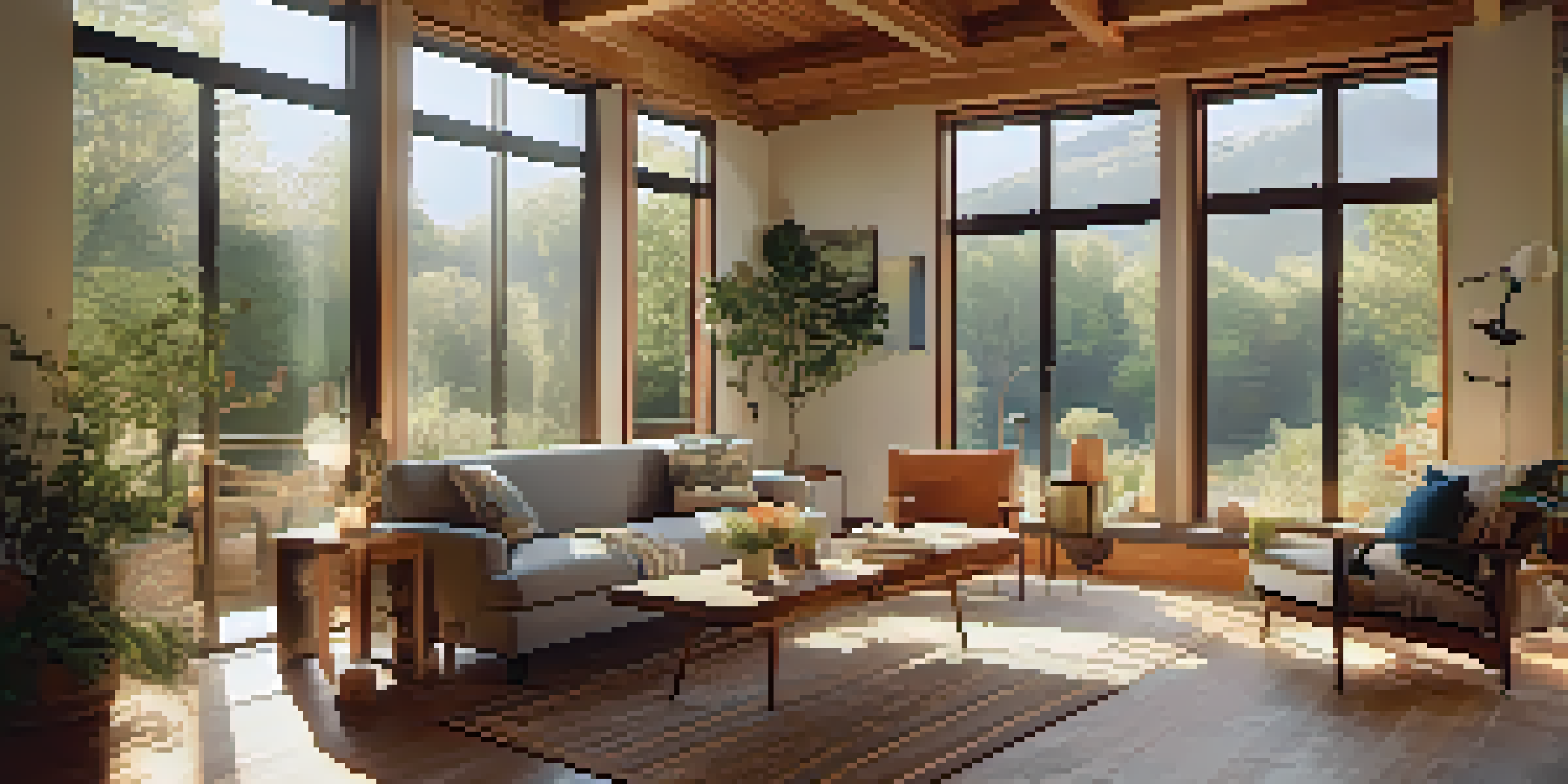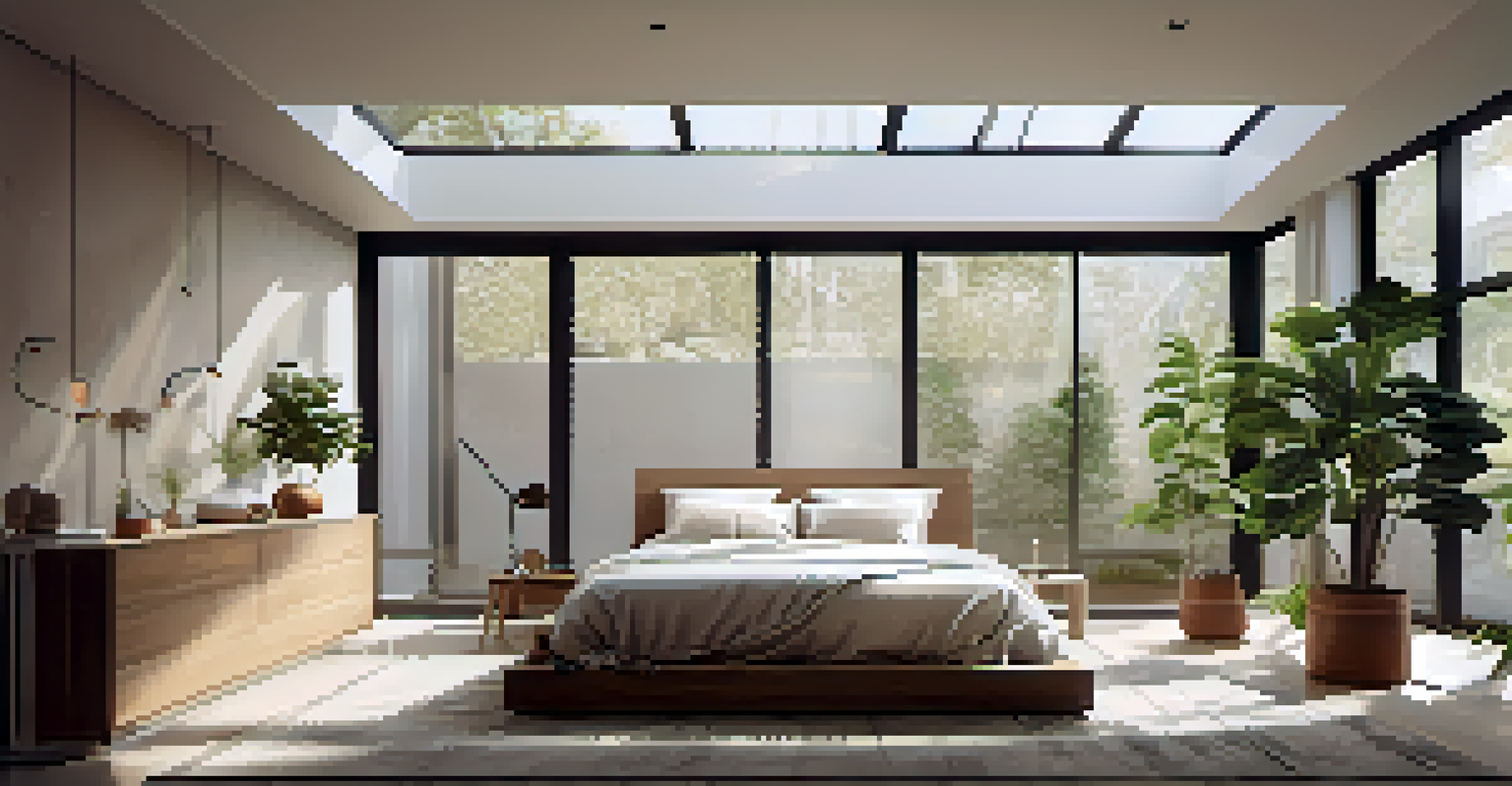Building Passive Solar Homes: Key Benefits

Understanding Passive Solar Design and Its Purpose
Passive solar design focuses on utilizing the sun's energy for heating and cooling without relying on mechanical systems. This approach leverages natural resources, creating a comfortable living environment while minimizing energy consumption. Essentially, it’s about designing homes that work with nature rather than against it.
The sun is the primary energy source for life on Earth. By harnessing its energy, we can create homes that are not only comfortable but also sustainable.
The goal is to maximize sunlight exposure through strategic placement of windows, thermal mass, and insulation. By doing so, a passive solar home can maintain a consistent temperature throughout the year. This design methodology aligns perfectly with sustainable living practices, promoting an eco-friendly lifestyle.
By understanding the principles of passive solar design, homeowners can make informed choices about their building materials and layout. This knowledge empowers individuals to create structures that not only look beautiful but also function efficiently, reducing reliance on external energy sources.
Energy Savings: Lower Utility Bills and Environmental Impact
One of the most appealing benefits of building a passive solar home is the significant reduction in energy costs. By harnessing the sun's natural energy, these homes can maintain comfortable temperatures with minimal reliance on heating or cooling systems. This can lead to substantial savings on monthly utility bills.

Moreover, using less energy not only benefits homeowners financially but also has a positive impact on the environment. With reduced energy consumption, there’s less demand on power plants, leading to lower greenhouse gas emissions. This creates a win-win situation for both the wallet and the planet.
Energy Efficiency Reduces Costs
Passive solar homes significantly lower utility bills by harnessing the sun's energy for heating and cooling.
In the long run, these energy savings can add up significantly, making passive solar homes a wise investment. Homeowners can enjoy a sustainable lifestyle while contributing to a healthier environment, all thanks to the power of the sun.
Enhanced Comfort: Consistent Indoor Temperatures Year-Round
Passive solar homes are designed to maintain a comfortable indoor climate, regardless of the season. By carefully planning the orientation of the home and the placement of windows, these homes can capture sunlight during the colder months and minimize heat during the summer. This results in a more stable and enjoyable living environment.
Sustainable design is not just about building green; it's about creating spaces that are in harmony with nature and enhance our well-being.
The use of thermal mass materials, such as concrete or brick, helps to store heat during the day and release it slowly at night. This feature ensures that the temperature inside the home remains consistent, reducing the discomfort of sudden temperature fluctuations. Homeowners can appreciate a cozy atmosphere without excessive reliance on heating or cooling systems.
Additionally, this consistent indoor temperature can lead to better overall health and well-being. A comfortable environment promotes relaxation and productivity, making passive solar homes an excellent choice for families and individuals alike.
Natural Lighting: Brightening Up Living Spaces
Another fantastic advantage of passive solar design is the abundance of natural light it can bring into a home. By strategically placing windows and using skylights, homeowners can illuminate their spaces without relying heavily on artificial lighting. This not only saves energy but also creates a warm and inviting atmosphere.
Natural light has been shown to improve mood and productivity, making homes feel more vibrant. Imagine walking into a sun-soaked living room that energizes your spirit and encourages creativity. Passive solar homes provide this uplifting experience while also reducing the need for electric lighting.
Enhanced Comfort Year-Round
These homes maintain consistent indoor temperatures, promoting a cozy living environment without excessive reliance on HVAC systems.
Moreover, the design of passive solar homes often emphasizes views of the outdoors, connecting residents with nature. This connection not only enhances aesthetic appeal but also promotes mental well-being, creating a harmonious balance between indoor comfort and outdoor beauty.
Increased Property Value: Attracting Eco-Conscious Buyers
As the demand for sustainable living solutions rises, passive solar homes are becoming increasingly attractive to potential buyers. Many homebuyers are now prioritizing energy efficiency and eco-friendly features in their search for a new home. This trend means that passive solar homes can see a boost in property value.
Investing in a passive solar home can lead to a higher resale value compared to traditional homes. Buyers often recognize the long-term savings on energy bills and the benefits of a comfortable living environment. This growing awareness of sustainability trends makes these homes a sought-after option.
Additionally, passive solar homes often come with unique architectural features that set them apart from conventional designs. This uniqueness can further enhance their appeal, making them not only an environmentally friendly option but also a desirable investment in the real estate market.
Sustainability: A Step Towards a Greener Future
Building passive solar homes is an impactful way to promote sustainability and reduce our carbon footprint. By utilizing natural resources, these homes demonstrate a commitment to eco-friendly practices. This aligns with the global movement towards sustainable living and preserving our planet for future generations.
The construction of passive solar homes often involves using renewable materials and energy-efficient technologies. This not only conserves resources but also supports local economies by prioritizing locally sourced materials. By choosing sustainable practices, homeowners contribute to a healthier planet and a more resilient community.
Boosted Property Value
As eco-conscious living trends rise, passive solar homes attract buyers and can command higher resale values.
By embracing passive solar design, we can collectively work towards reducing greenhouse gas emissions and lowering energy consumption. It’s a proactive approach to combating climate change and ensuring a better world for the generations to come.
Improved Indoor Air Quality: Healthier Living Environments
Passive solar homes often feature designs that enhance indoor air quality, which is crucial for overall health. With proper ventilation and the use of non-toxic building materials, these homes can provide a healthier living environment for residents. Good air quality can lead to improved respiratory health and overall well-being.
Natural ventilation strategies, such as strategically placed windows and vents, allow for fresh air circulation without excessive energy use. This helps to eliminate indoor pollutants and moisture, creating a more comfortable and healthy atmosphere. Homeowners can breathe easy knowing their living space is both safe and pleasant.

Additionally, many passive solar homes incorporate plants and greenery into their design, further enhancing air quality. This connection to nature not only beautifies the space but also promotes mental health, creating a holistic approach to home living.
Resilience: Adapting to Environmental Changes
Building passive solar homes can enhance resilience against changing environmental conditions. As climate change continues to affect weather patterns, these homes are designed to adapt to various conditions, providing comfort regardless of external factors. This adaptability makes them a smart choice for homeowners.
The energy efficiency of passive solar homes means they are less reliant on external energy sources, making them more resilient during power outages or energy crises. Homeowners can feel secure knowing their living space can thrive even in challenging situations. This independence is a significant advantage in today's unpredictable world.
Furthermore, by reducing energy consumption and promoting sustainable practices, passive solar homes contribute to a more stable environment. This resilience not only benefits individual homeowners but also strengthens communities, making them better equipped to face future challenges.